
The Brooklands oval in the UK was home to the fastest cars on earth for the 32 years it was open, and the modern Brooklands Museum celebrates this fact with an impressive collection of cars from both the track’s glory period and the post-war years following the circuit’s closure. This means the chance to see Senna’s ’91 F1 McLaren…

…on the same day as something like the stunning and unique Alfa Romeo 6C Aerospider. Walking the epic Brooklands banking and seeing the outdoor exhibits can take up a good portion of a day, but with the beautiful cars on show it’s important to leave enough time to soak up all the displays that the Museum has on offer.
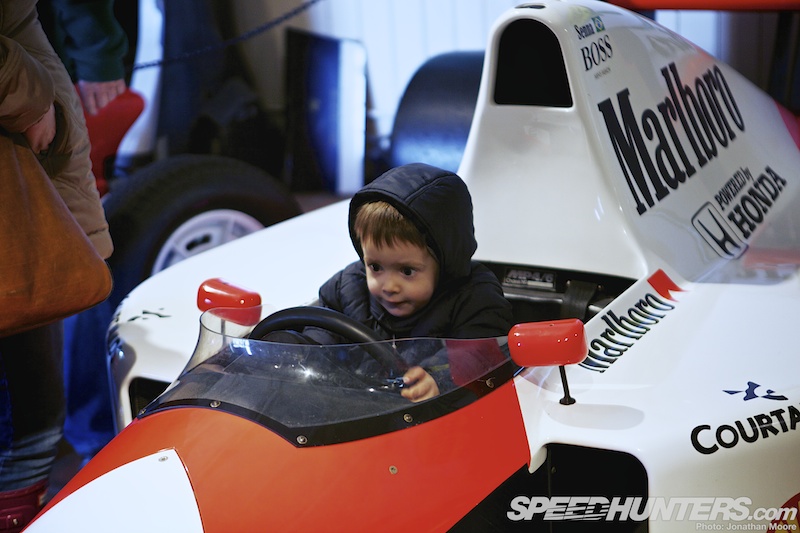
It’s also the kind of place where lifelong obsessions are born.
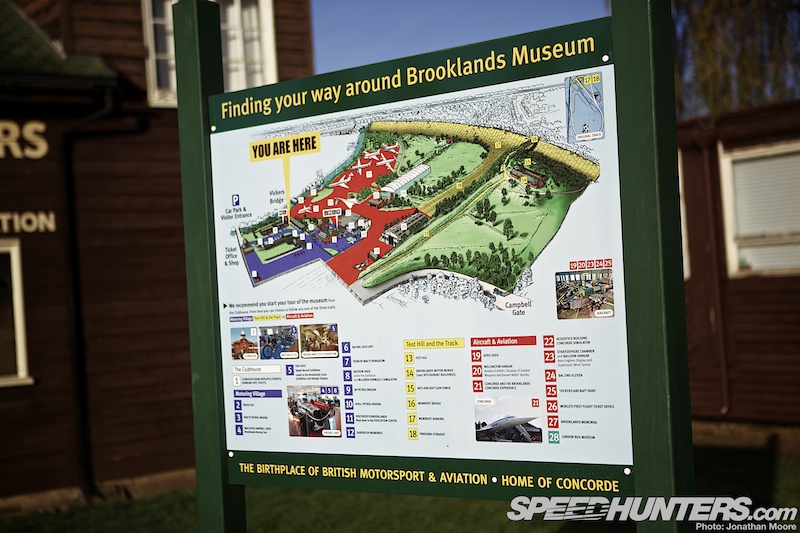
Brooklands Museum takes up a large corner of the original track: it includes a large section of the original Members Banking plus buildings dedicated to the motorsport and aviation history of the site. Restored buildings from the track’s active era are supplemented by the big aircraft hangars from WWII and subsequent decades.
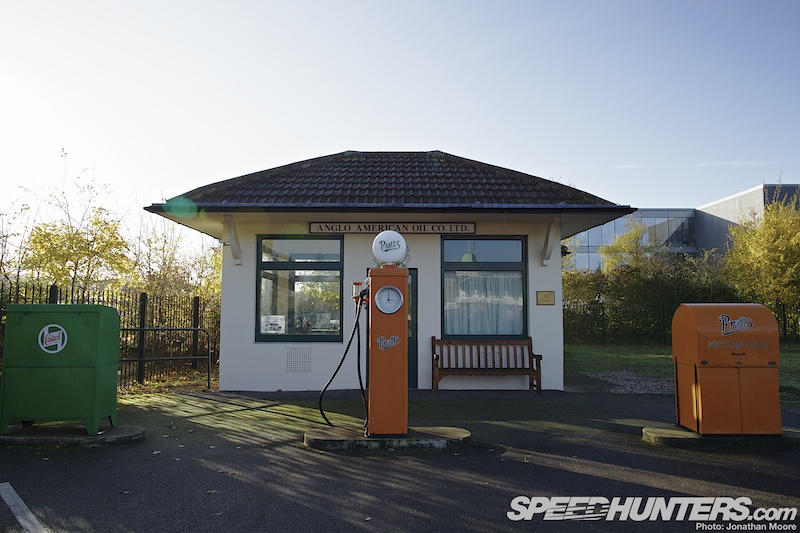
The Pratts/Esso Petrol Pagoda was constructed in 1922, one of four original filling stations at Brooklands – all the major oil companies of the time were represented. Pratts Motor Spirit became Esso (from a phonetic pronunciation of the letters of Standard Oil, of which Charles Pratt was a founder) in 1935, at which time the corporate identity on the pagoda was changed.
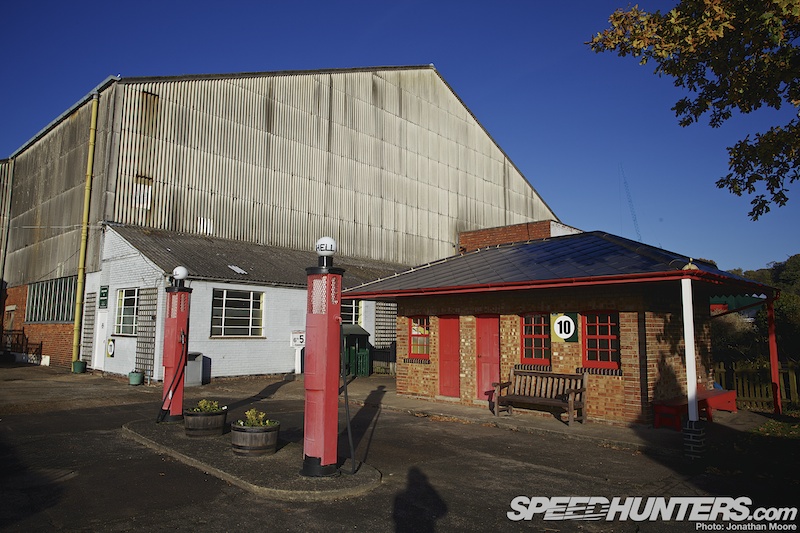
Of the three other filling stations, the Shell and BP buildings have been restored, but the balloon hangar now occupies the site where the Redline pagoda once stood.
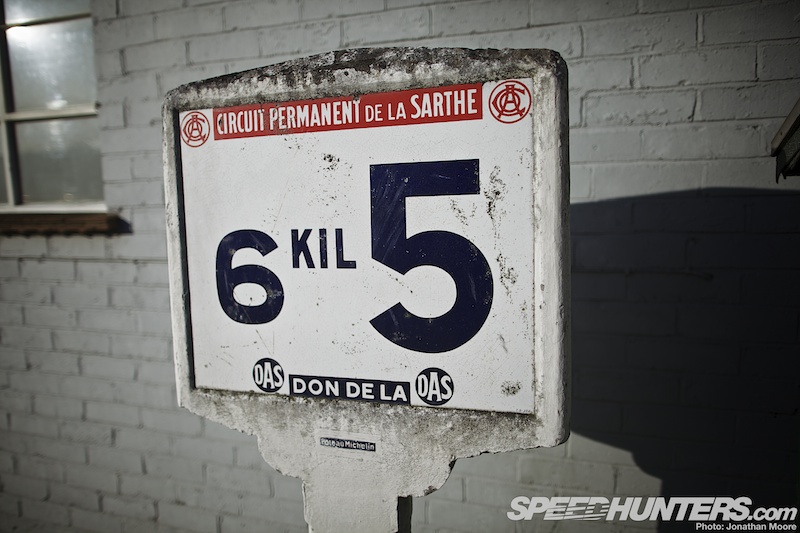
Brooklands’ links to the famous race across the channel at Le Mans are celebrated with a display of one of the original concrete half-kilometre markers from the Circuit De La Sarthe.
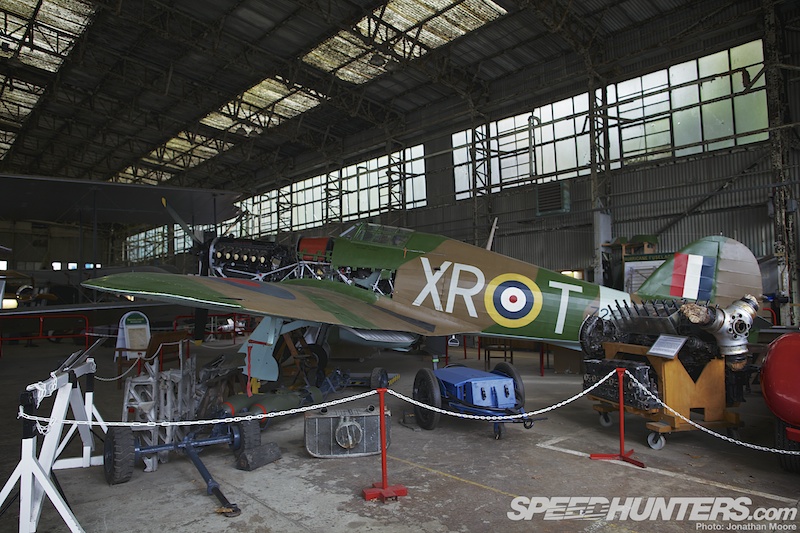
Aviation became as important as racing to Brooklands early on in the track’s life: flying conditions were helped by the barrier of the high-banked oval. During the Second World War, the factories at the site churned out Hurricane fighters and Wellington bombers. A group of volunteers work in this hangar on restoring a Hurricane and also a Wellington bomber that was recovered from Loch Ness in Scotland – without any interference from monsters…
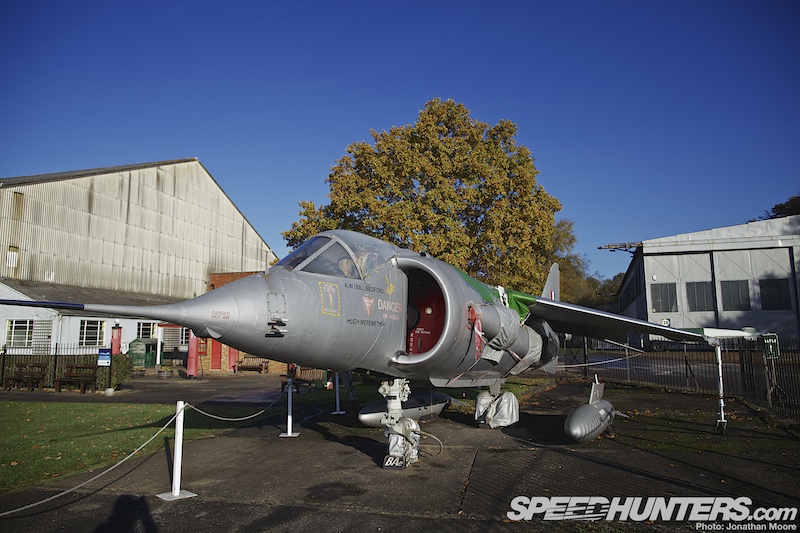
Aviation research and development continued at Brooklands into the ’50s and ’60s, with major jets of the era emerging from Brooklands’ hangars. Many other important planes are now on display in and around the hangars, including this Hawker P1127 – one of the prototypes from which the astonishing VTOL Harrier was born. There’s also a two-seater trainer that you can sit in!
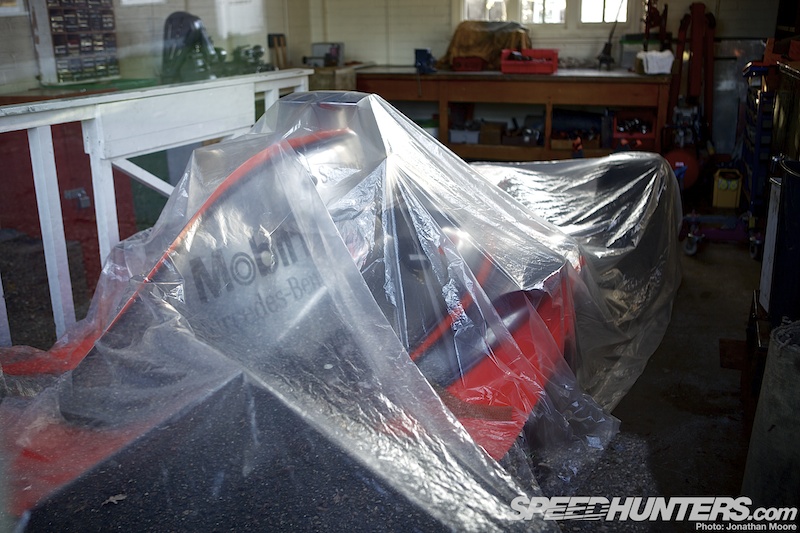
But cars are what we’re hunting – and they can be found everywhere. Parked up outside, in sheds, under awnings… McLaren had just delivered a recent Formula 1 car which is due to be turned into a simulator and was sitting in Dunlop Mac’s Tyre Depot shed, the oldest building at Brooklands.

The Clubhouse houses a small collection of cars and memorabilia and several restored rooms reflecting how the interior of the building would have looked in its heyday.
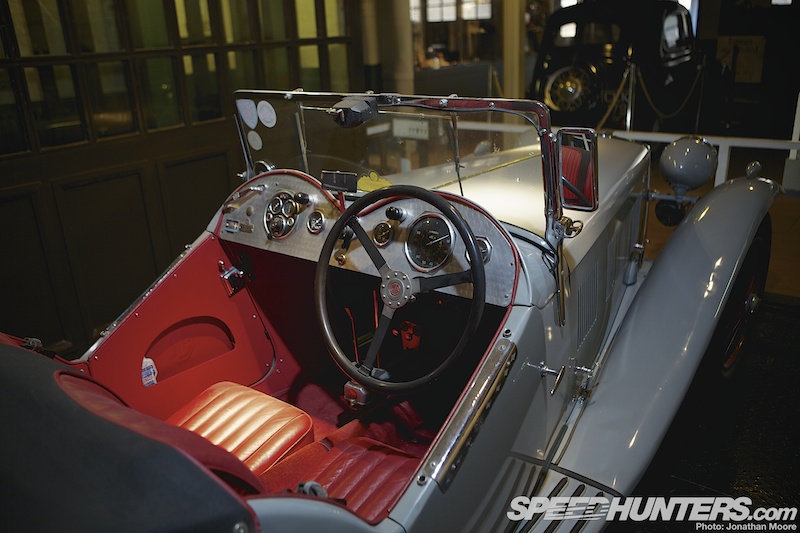
The MG L2 Magna roadster mounted a one-litre, six-cylinder and was a very successful competition car. A factory trio won the Light Car Club Relay Race at Brooklands in 1933, and later that year a celebrity race was run using 10 new L2s.
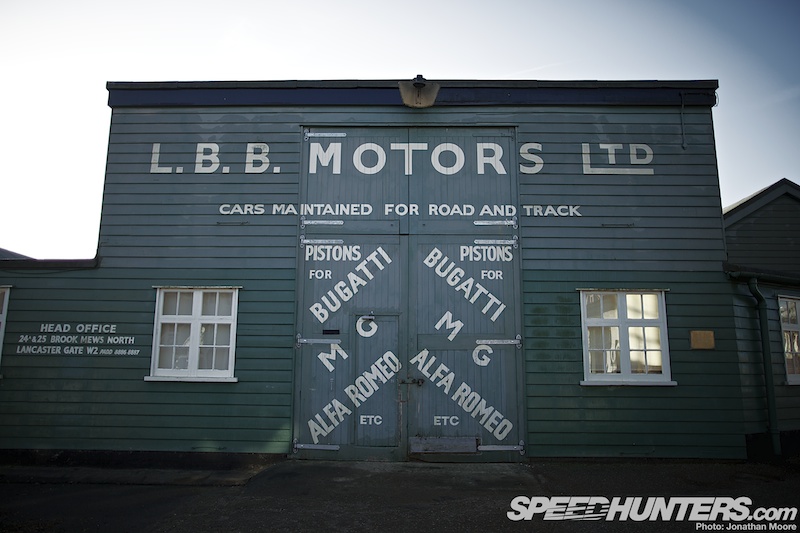
Across the courtyard is the LBB Motors Shed, home to the major collection of the Brooklands Museum: the ‘Fastest On Earth’ Speed Record Exhibition. The high doors were to allow double-decker buses to be brought in, which the LBB company were converting to diesel in the 1930s. The ERA racing team and Brooklands Engineering Company also previously occupied the workshop.
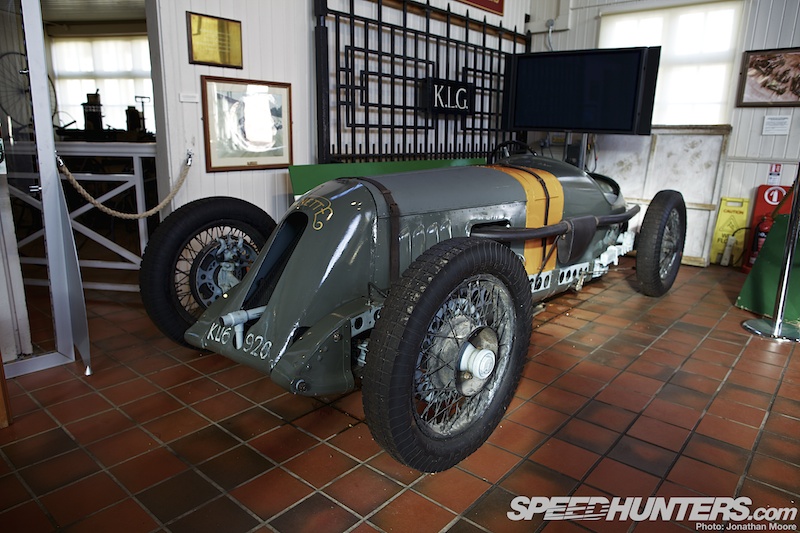
The Nanette Brooklands Special was commissioned in 1924 by racing driver Felix Scriven. The original two-litre six-cylinder was quickly replaced by a more reliable 1.8-litre four-cylinder, and Scriven took his unique Brooklands Special to victory in its first race.
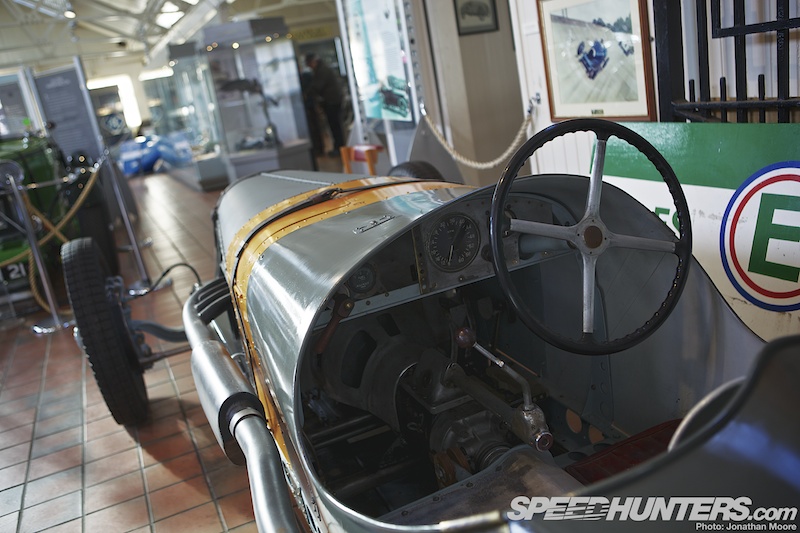
It must have been a terrifying experience. Imagine being in this car, travelling at an average 90mph along the bumpy, treacherous surface of Brooklands, no seat belts, no helmet, no bucket seat, the transmission burning your legs and the wind threatening to rip the bodywork off… Oh, and the car twice caught fire during races, the second time leaving only the engine and front wheels serviceable.
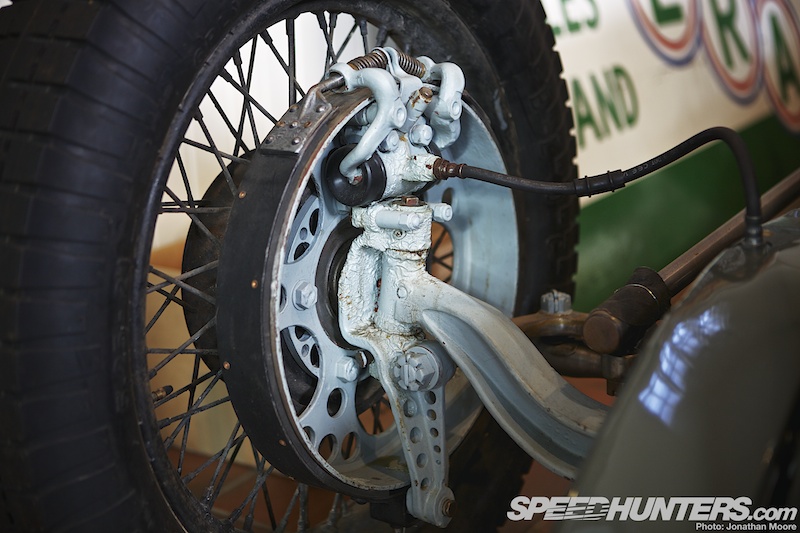
The suspension and brakes look positively medieval: the surprise was actually having brakes at the front – not all cars of the time did…
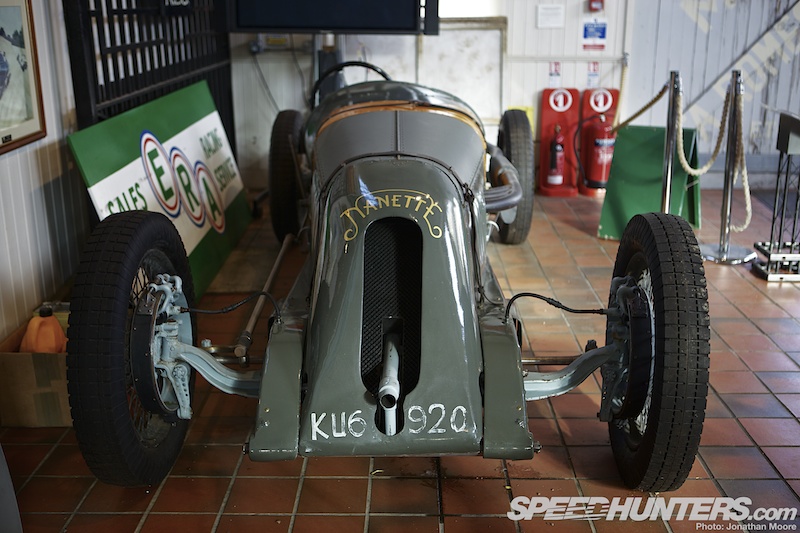
Nanette was later modified again in 1927 to take a 1.5-litre supercharged unit, which must have made it even more unpredictable at speed.
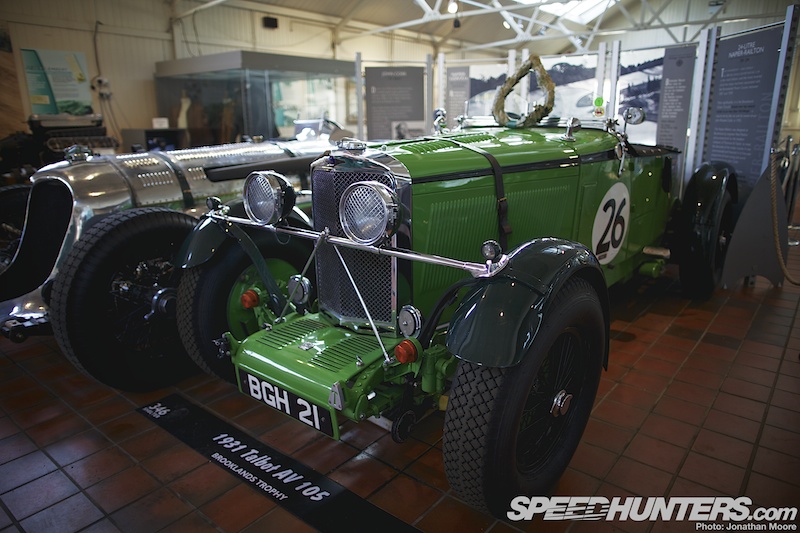
Rather more refined was this luscious 1931 Talbot AV105 in its bright green factory livery, a model that competed in the famous Double 12 races at Brooklands. In high-compression competition mode the 2.9-litre straight six (a stressed member) put out over 140bhp, and AV105s scored podiums at Le Mans, Brooklands and at the Alpine Trials.
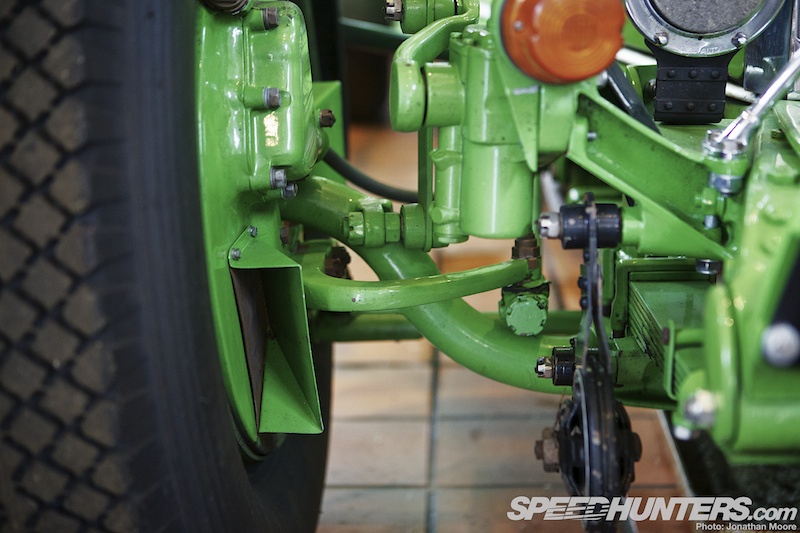
Even though the metalwork seems thick and complex, you can still pick out early examples of applied racing technology like the brake cooling ducts and friction dampers.
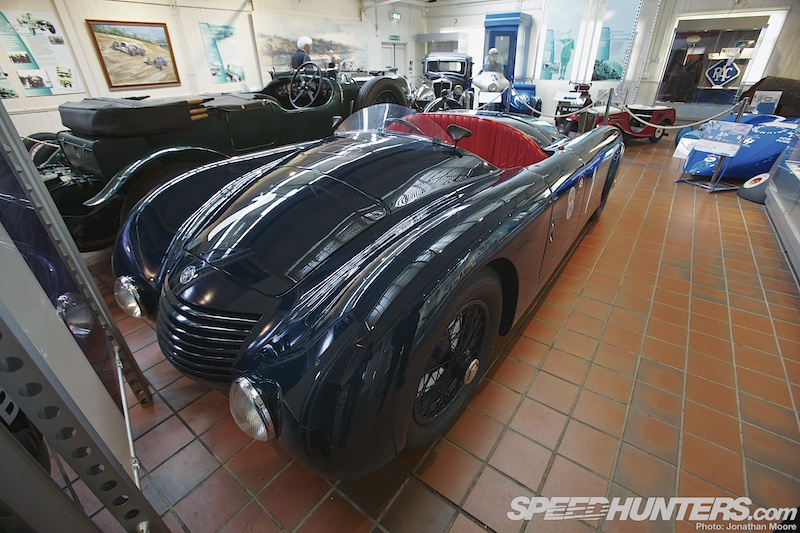
Along with the Talbot, the Museum had another new addition in 2012: this beautiful one-off Alfa Romeo 6C 2300 Aerospider. Aerodynamics featured heavily: it was Alfa’s attempt to take on the dominating German teams of Auto Union and Mercedes-Benz, and the 6C would have been capable of 200mph in its 12C, 430hp competition form. The car almost looks like it’s designed in reverse, with a bluff nose designed to counter lift tapering over a low-profile body to an elongated tail. The underneath was as important as the top: it had a flat underbody to reduce turbulence.
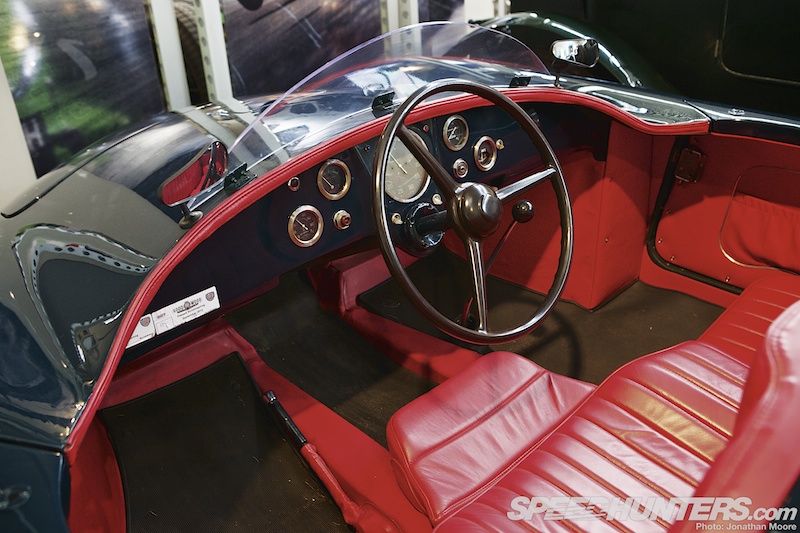
It was also the first mid-engined car with a central driving position – 60 years ahead of the McLaren F1, although there was a fair chance that you wouldn’t remain in the central driving position if you went around a corner, thanks to the leather bench seat and lack of belts.
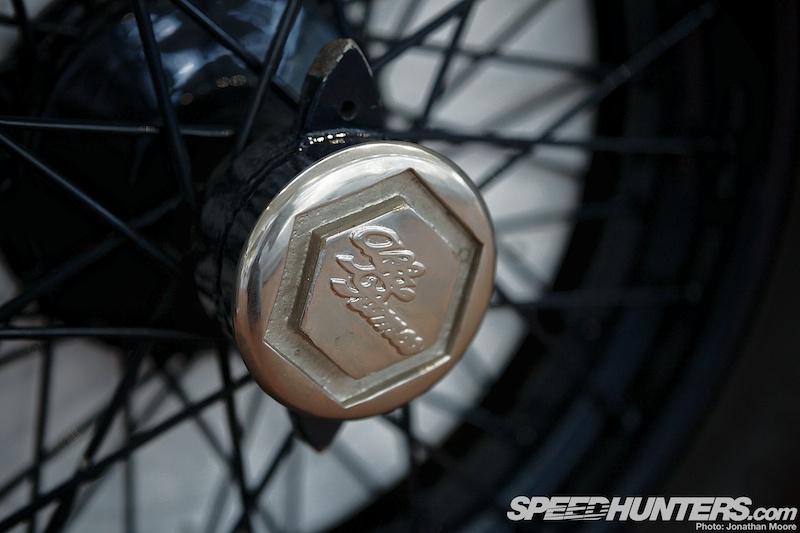
The thinking behind the car wasn’t just skin deep: the Alfa was the most advanced pre-war chassis around, with a twin circuit brake system controlled by an equaliser to distribute braking force between the front and rear. That was matched with a hydraulically-assisted clutch, pre-selector gears and advanced cooling to cope with the mid-engine. The only shame is that there’s not a lot of room in its current position to truly appreciate it.
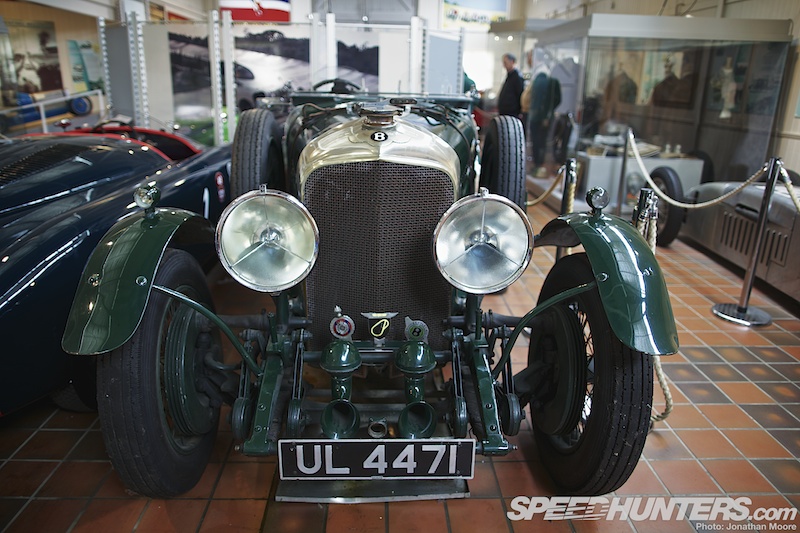
Bentley is synonymous with Brooklands: this is a 1929 4.5-litre model with a Vanden Plas body. It was originally supplied with racing Le Mans bodywork and competed in the first Double 12 event driven by its owner, HN Holder, alongside Henry ‘Tim’ Birkin: perhaps the best-known British driver of the ’20s and early ’30s.

This particular car wasn’t a hugely successful racer at Brooklands though: it retired in its first two races, but did score a podium in the Bentley Drivers Club Race in 1936.
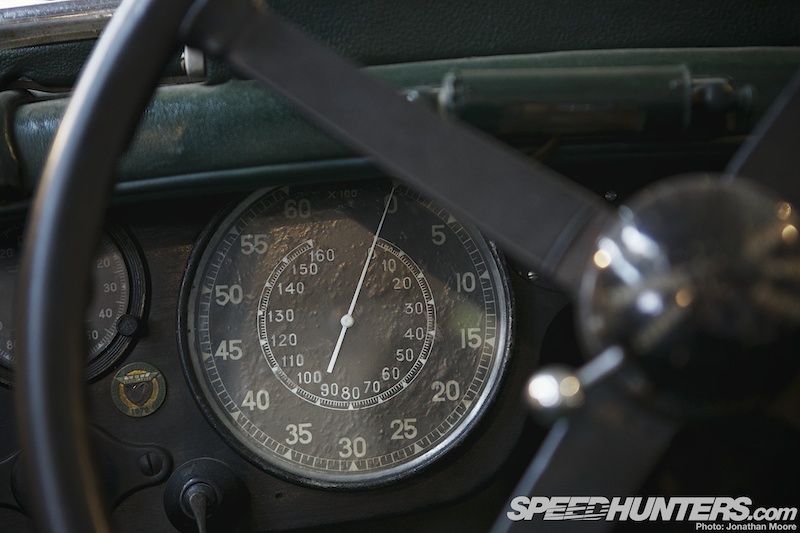
Nonetheless, these were fast cars, and how can you not love a car whose slogan was ‘There’s no replacement for displacement’.
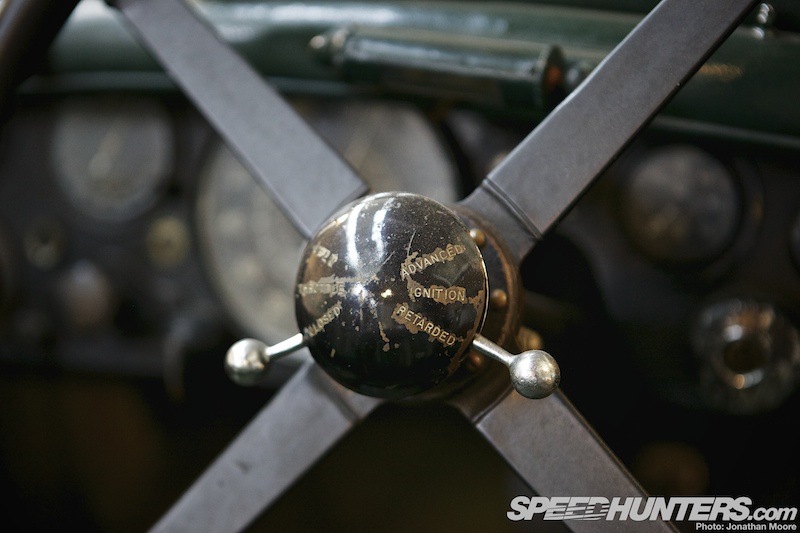
It’s hardly as complex as a modern F1 car, but the Bentley still had spark and choke controls mounted on the steering wheel for easy access.
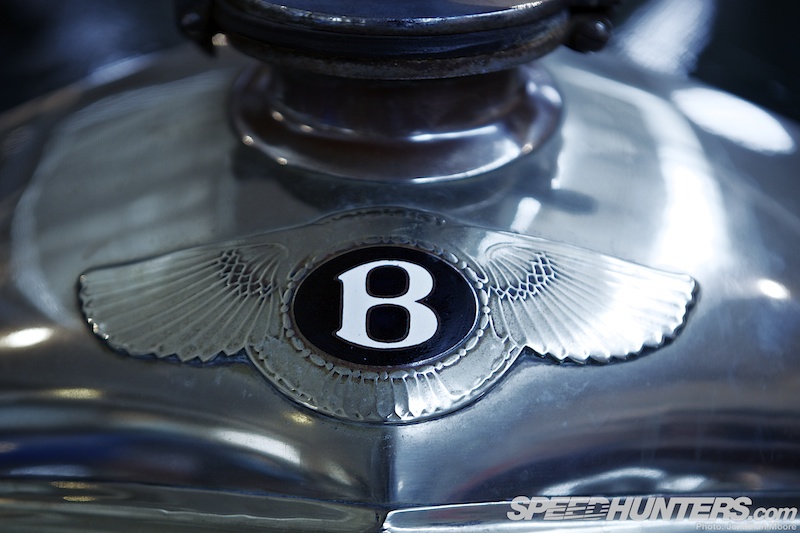
The most famous Bentley combination was a red single-seater-bodied Blower with Birkin at the wheel: he took the Blower to several lap records, the final one being an average speed around the Outer Circuit of 137.96mph. In a car like this.
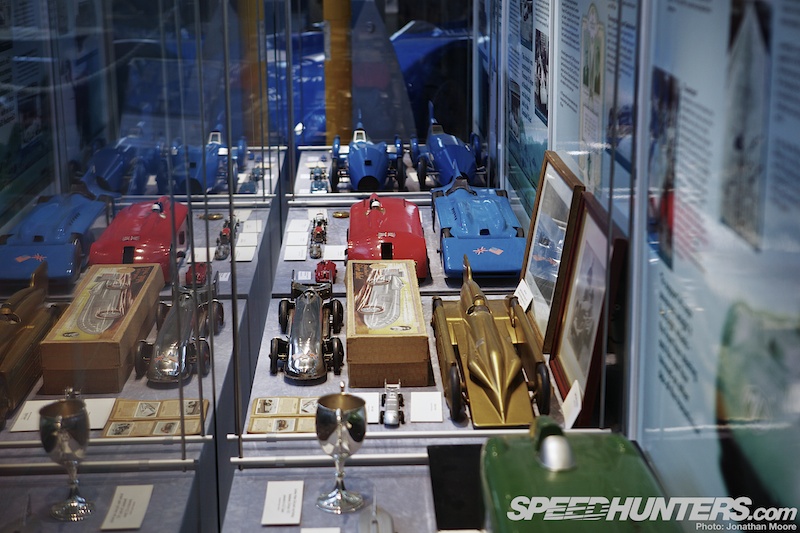
Brooklands’ super-fast nature lent itself to speed records, though as maximum velocities climbed it became more of a development base for cars like Malcolm Campbell’s Land Speed Record Bluebirds. John Cobb and Sir Henry Segrave were also Brooklands racers turned LSR specialists, in their Railton and Golden Arrow respectively.
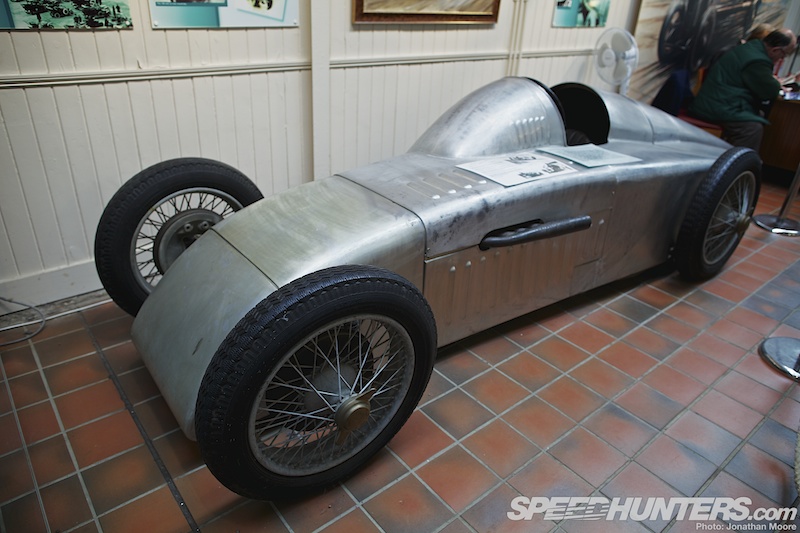
As ever, speed attracts the individual as much as the factories. This diminutive Ridley Special was a record holder in the 750cc Class H in 1931, taking on and beating the furious works Austin and MG teams by setting a flying mile speed of 104.5mph.
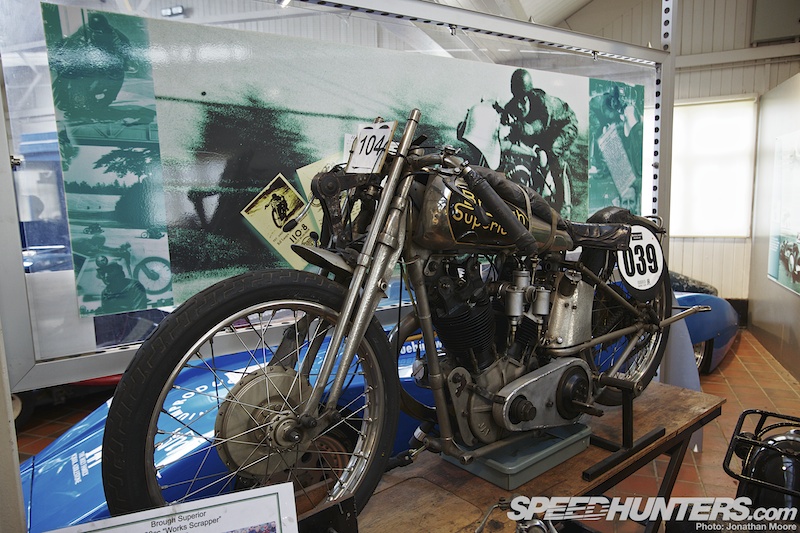
Bikes featured strongly at Brooklands, and this low-slung Brough Superior ‘Works Scrapper’ is indicative of the motorcycles that took to the track. This 1,000cc bike was ridden as a sidecar combination to break the 100mph average speed and even faster solo. Yet again, the cojones of competitors at Brooklands can’t be doubted.

And what is a car collection without a Model T Ford? This is the 1916 Open Tourer version of the ‘Tin Lizzy’, a three-litre engined variant. Model Ts were regularly raced at Brooklands from 1910 and two races were held specifically for Fords in 1912 – one of which was attended by Henry Ford, who also presented the winner’s trophy.
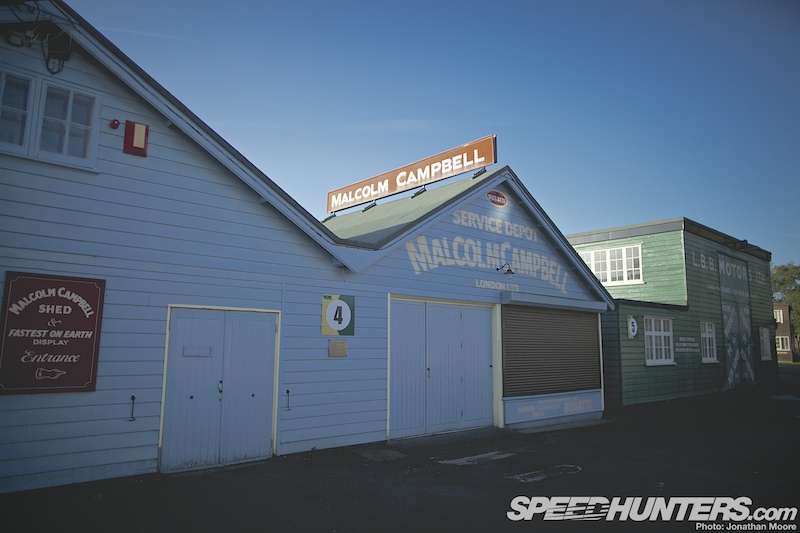
The collection continues through an internal corridor to the Malcolm Campbell Shed next door, originally constructed in 1926 and then extended in 1931. This was his office, showroom and workshop; many of the famous Bluebird racing and Landspeed Record cars were built or stored here, and he entered almost 300 races at Brooklands between 1911 and 1935 – nearly twice as many as any other driver.
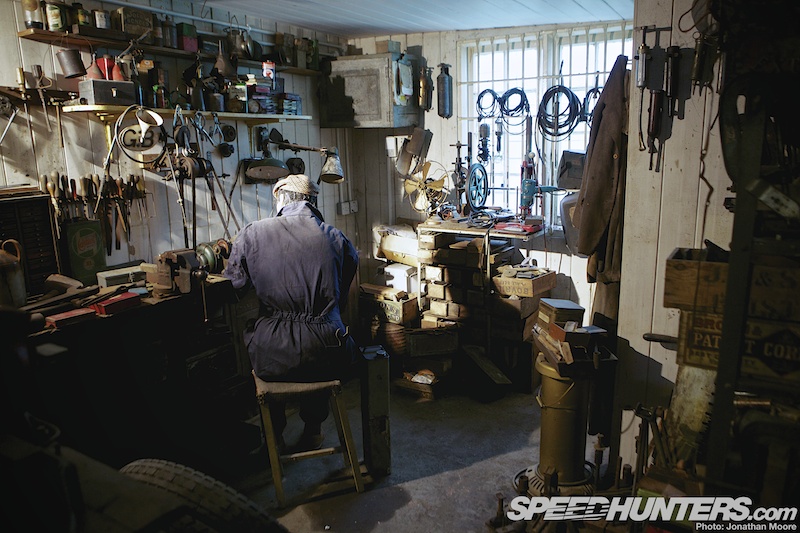
A recreation workshop shows the basic tools in use at the time: more familiar to an artisan carpenter perhaps than a modern racing team… The interior is based on a real 1920s garage originally in Bromley, Kent, which was dismantled and reassembled as-was at its new home in Brooklands.
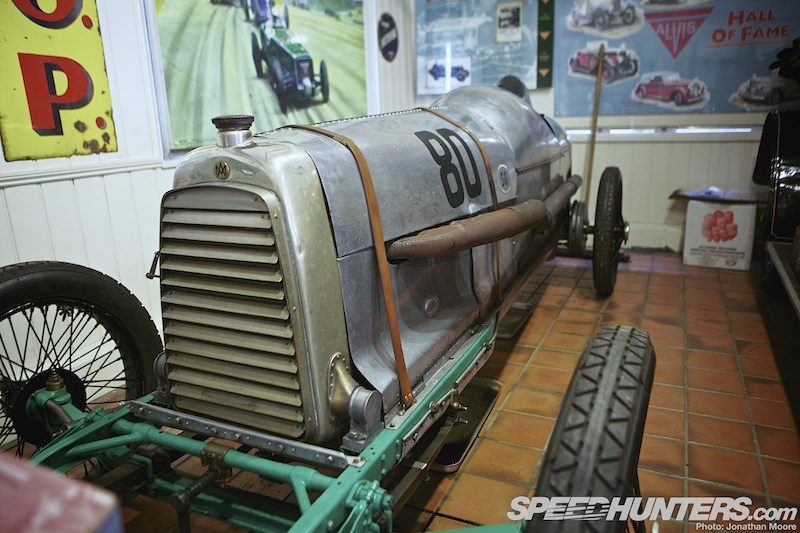
Although the big cars might have made all the noise, it was the lightweight classes where the manufacturer competition normally battled it out. Bugatti, Talbot, Darracq, AC and Alvis all promoted the brand through racing, and the fledgling Aston Martin team brought their Razorblade Special to the gunfight in 1923. The body was built by the De Havilland Aircraft Company, using their knowledge of streamlining and aluminium, and the radiator shutters could be controlled by the driver to adjust airflow.
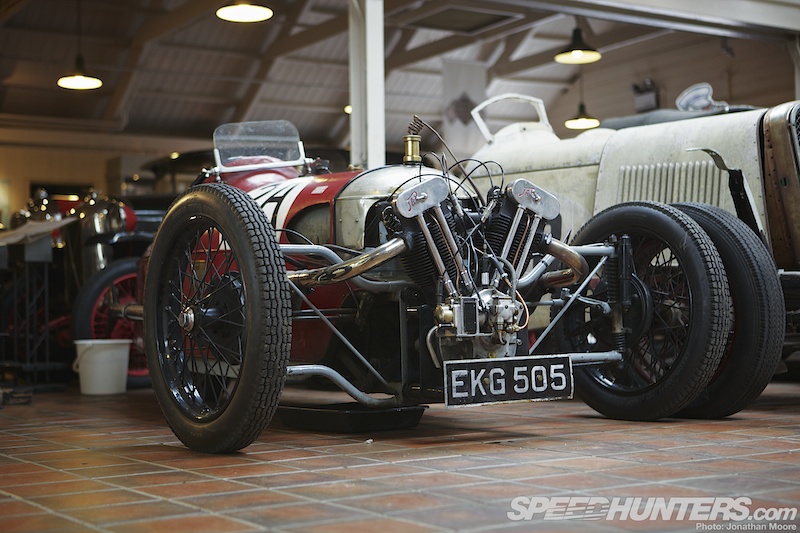
Now, is this car from 2012 or 1912? With a Morgan, it’s always difficult to tell… The firm started building three-wheelers in 1910, only moving to four-wheeled cars in 1936.
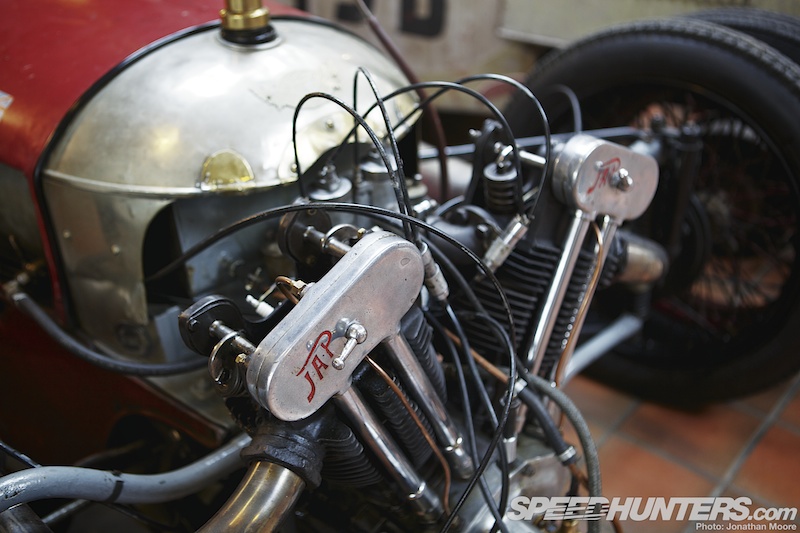
This three-wheeler is actually from 1929 – a Baragwanath-tuned JTOR 996cc JAP-engined racer that achieved 37 World Records and lapped Brooklands Outer Circuit at an average speed of 100mph, the first Light Car Class entrant to do so.
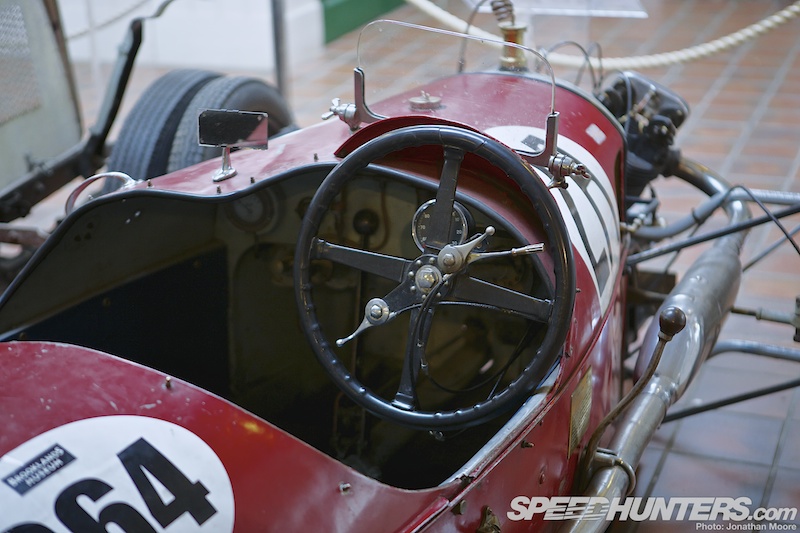
It was built to the bespoke specification for its owner, Clive Lones, who raced it between 1929 and 1935 with the tiny JAP bike engine exposed on the nose of the car.
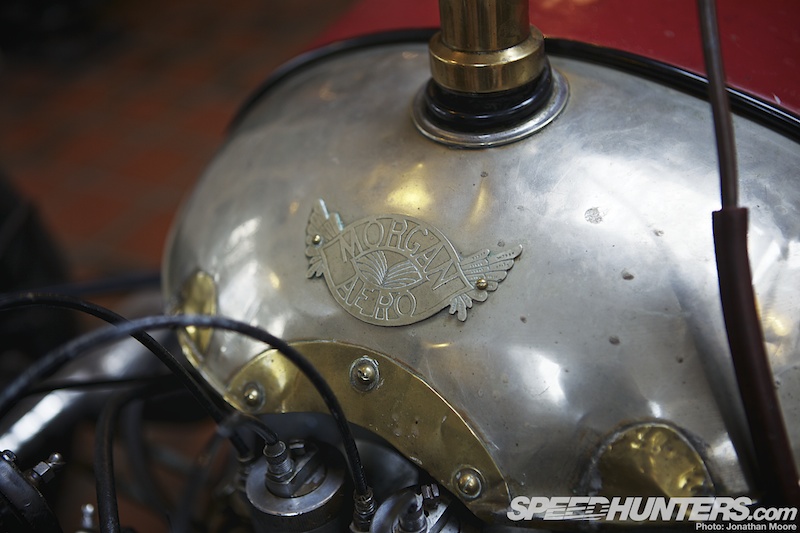
Morgan also used the car to experiment with pits-to-driver radio contact. I can’t help but think of some enormous unit hanging out the back… Unsurprisingly, the test was a failure, but it does possibly stand as the earliest use of such a technology.
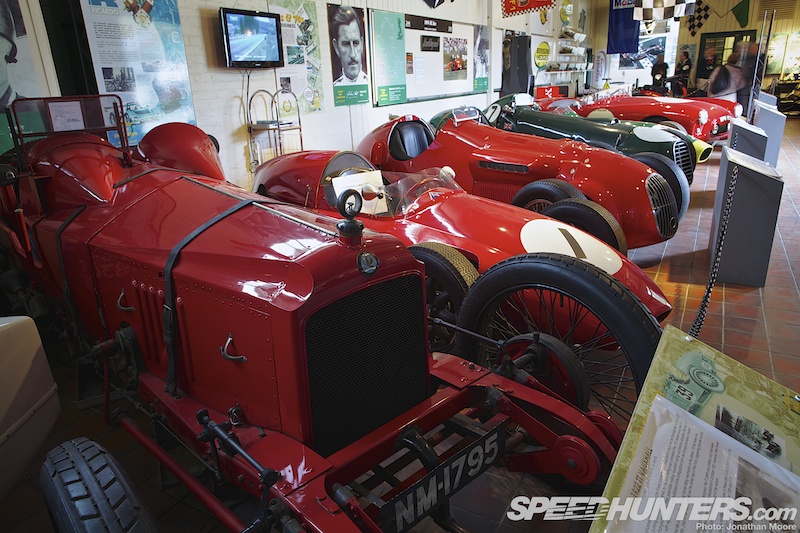
Further restored sheds are in a separate block, representing the lock-ups loaned out to individuals to run their cars from. Opposite, the RR Jackson shed houses the Museum’s Grand Prix Exhibition, showing off a century of Grand Prix racing.

From the beginning of the 20th century to the dawn of the 21st, the exhibition allows you to see the cars from all angles and even drive the Brooklands oval in a simulator.
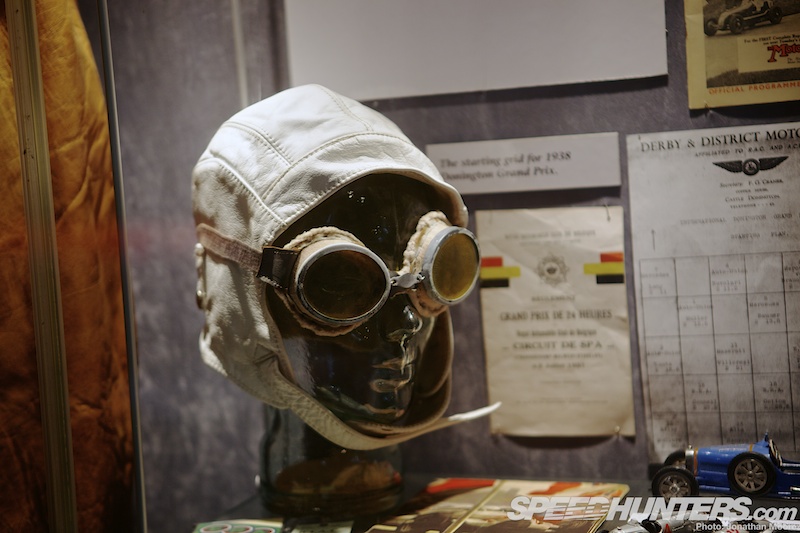
Although the early cars might not be to everyone’s taste, it’s when you put them in a human context that they transcend any aesthetic simplicity.
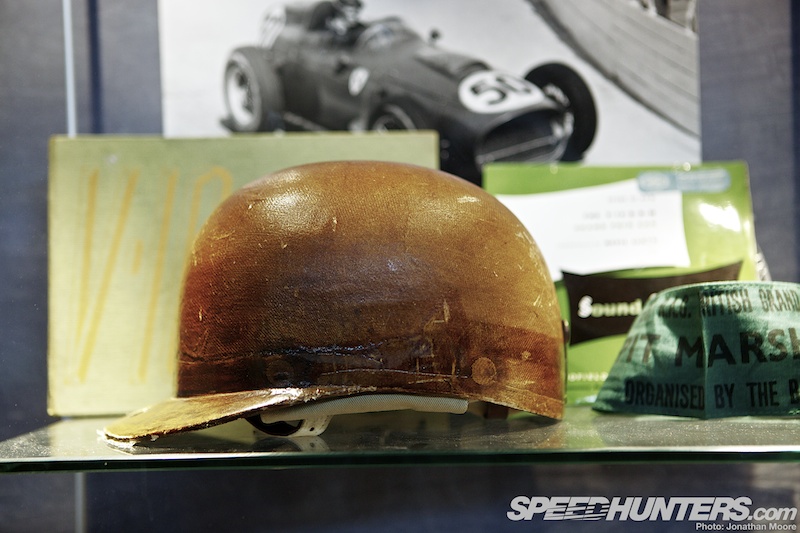
The drivers literally put their lives on the line each time they went out, taking their cars to unbelievable speeds in hugely dangerous conditions with zero protection. They were heroes, all.
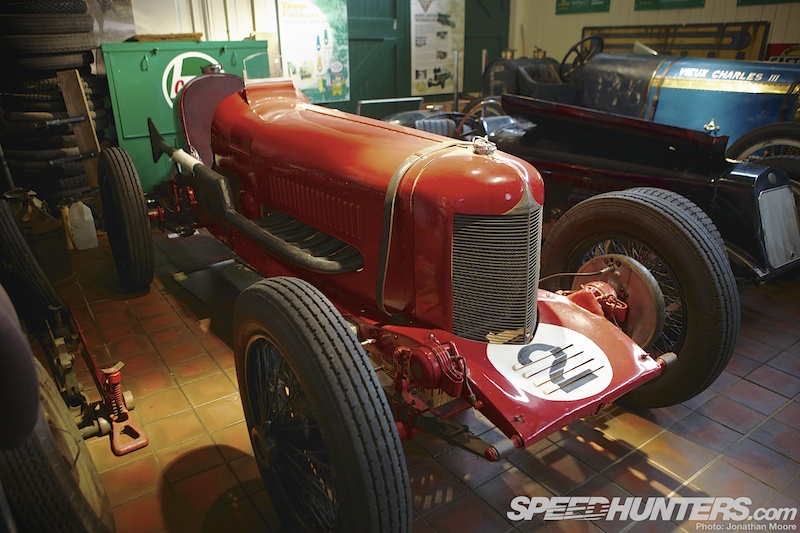
This is the only surviving 1927 Duesenberg, one of seven built at Indianpolis. In 1933 its original 1.5-litre engine was swapped out for a big 4.25-litre Clemons eight-cylinder unit to the order of the car’s owner: Count Trossi, president of Scuderia Ferrari! He drove it in the Italian Grand Prix that year, running second until retiring. It then raced at Brooklands in 1934, setting the fifth fastest ever overall lap speed. From then the car was regularly used to set flying laps of over 130mph average, hitting 145mph down the Railway Straight.
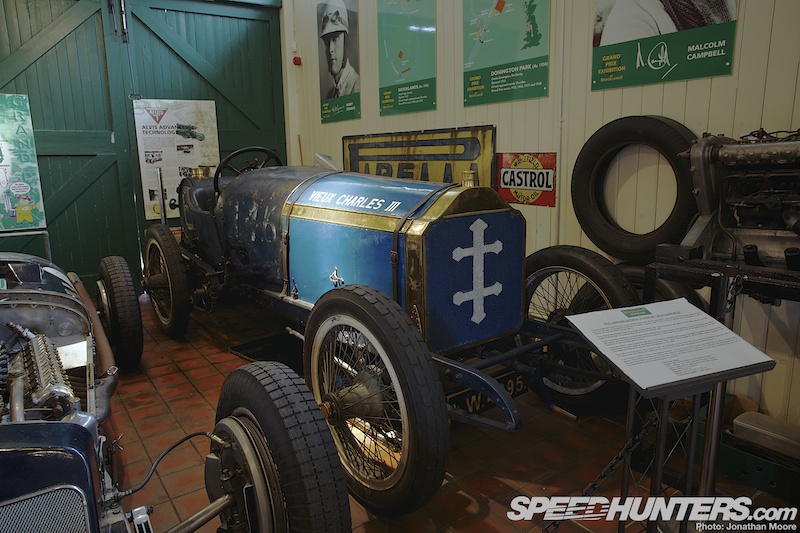
The other side of a low-line Delage is this big Lorraine Dietrich from 1912, the sole survivor of four team cars deployed by the French company for the Dieppe Grand Prix. Victor Hémery set three Brooklands records in this 15-litre beast: 500 miles at an average of 86.05mph; three hours at 94.82mph; and six hours at 86.36mph. Aerodynamics? Pah.
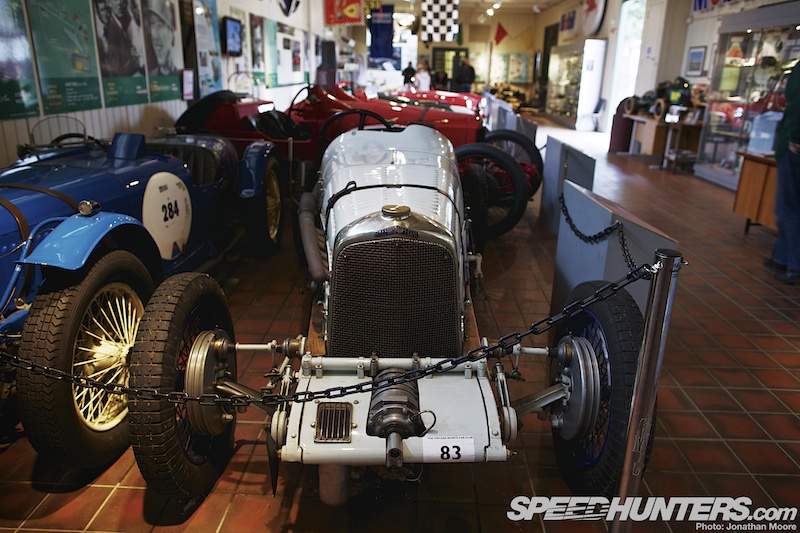
This Halford Special is another Aston Martin chassis, and a very advanced car for the time. The 1,500cc engine first had a turbo and then a Roots supercharger; Major Halford drove it to nine podiums in 1926, including three wins. Broken up in 1930, the present owner tracked down all the parts and restored the car to its original condition.
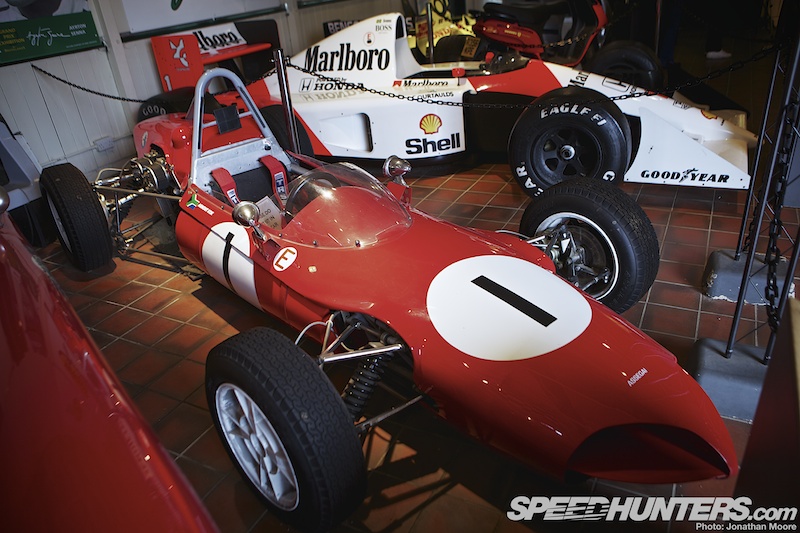
Alvis, Coopers and Vauxhalls led to this Assegai Alfa Romeo Formula 1 car from 1961. Built to the 1,500cc regulations, this shark-nose, lightweight (at just 490kg) single seater was the first all South African F1 car to be built.

The GP Exhibition’s 1979 Olympus Wolf WR7 had been converted back from its 1980 guise as a Fittipaldi F7, which may have explained some of the bodywork being a little skewed. But it’s still a great looking F1 car, and was raced by James Hunt and Keke Rosberg in the ’79 championship.
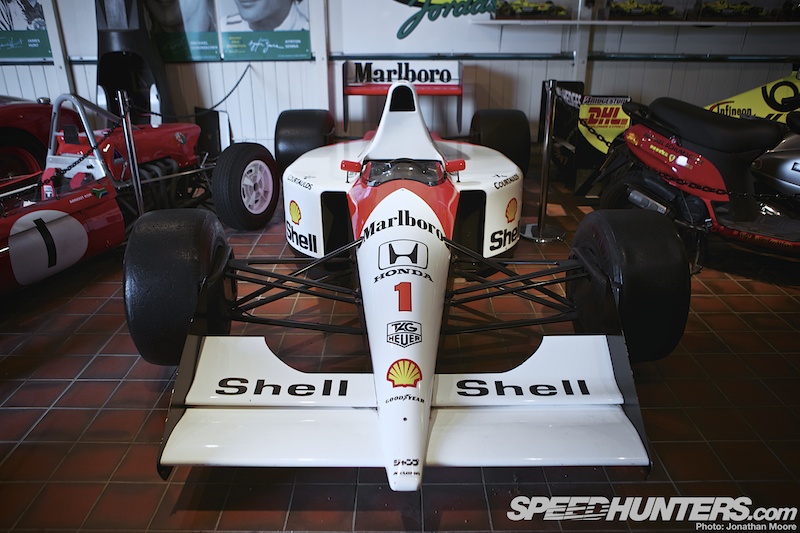
The jewel in the collection is this McLaren MP4/6. It’s only a rolling chassis, but it represents Aryton Senna’s hugely successful 1991 Honda-powered racer.
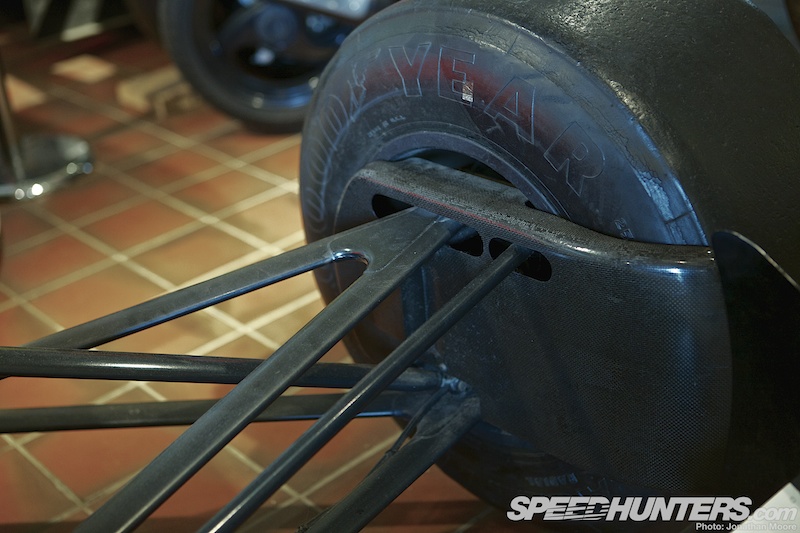
The weight of the car is astonishing: just 540kg, with the full use of carbon fibre and lightweight materials. The suspension set-up looks just a little more advanced than the Talbot and Nanette cars featured earlier…
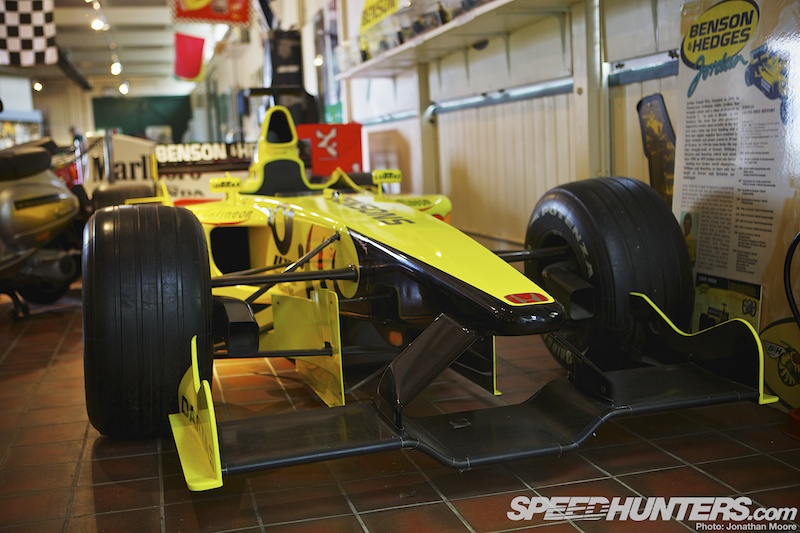
The newest complete car on show is this Jordan EJ11 from 2001, listed as being driven by Heinz-Harald Frentzen.
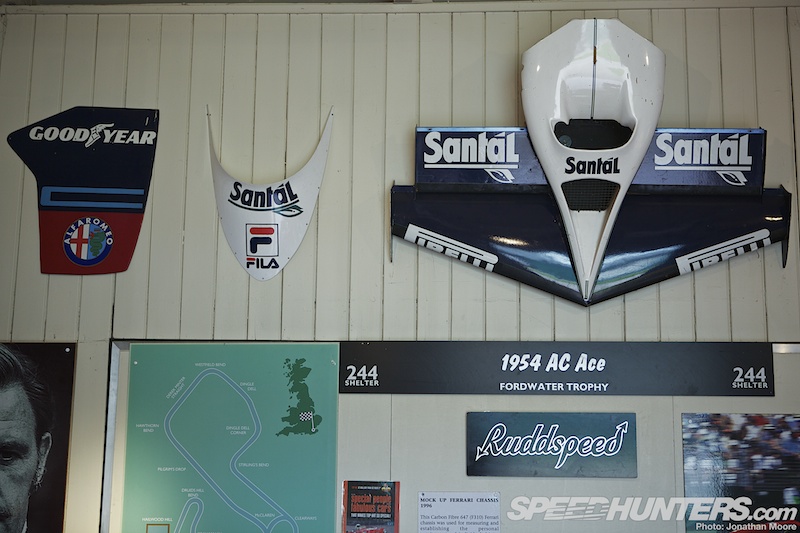
All the walls are taken up with memorabilia: collections of programmes, helmets, jackets, programmes – and even parts of old F1 cars.

The GP Exhibition also has another workshop recreation, based in and on the original lean-to added to the back of the RR Jackson shed in the 1930s and with all the tools and benches shown as they would have been. Jackson was well known as an engineering specialist, and produced many Brooklands specials from this workshop.
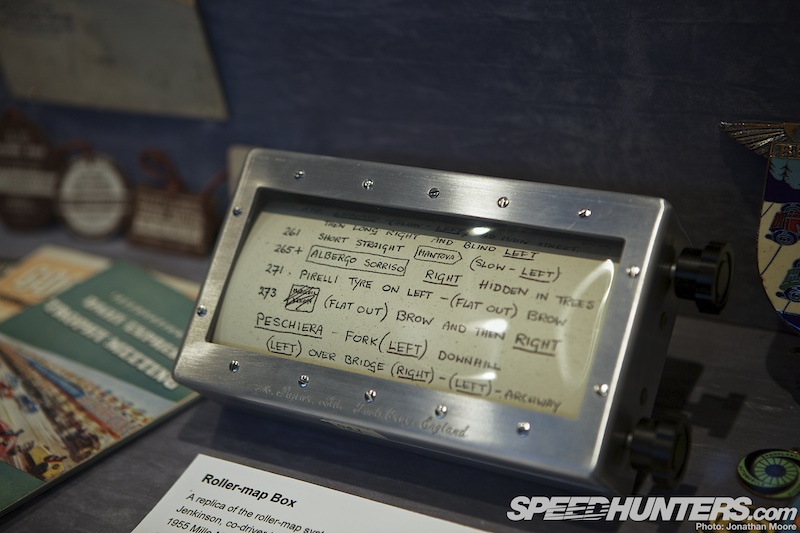
An unexpected display was this replica of the roller-map box used by Sterling Moss and navigator Denis Jenkinson on their famous Mille Miglia run in 1955: a novel way to tackle fast-moving pace notes, which had to be delivered by hand signal because of the engine noise!
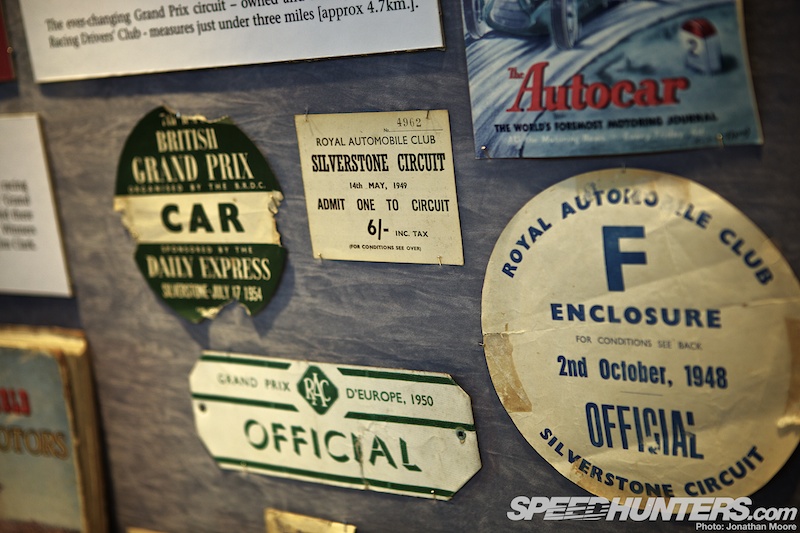
The Museum’s collection rotates around from time to time, meaning new cars are often loaned to the Museum and there’s always a good excuse to revisit the track and sheds. And hangars. And Concorde. And stratosphere chamber. And guided weapons exhibit. And so on. There’s one very important car I haven’t mentioned in this story, a racer that sums up the Brooklands spirit – and that will be next up as part of this Speedhunters Brooklands mini-theme.
Jonathan Moore
More museum stories on Speedhunters





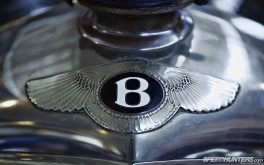
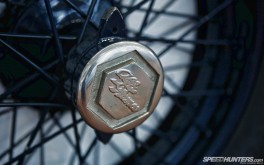
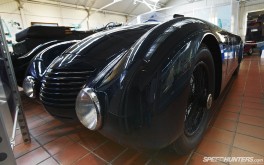
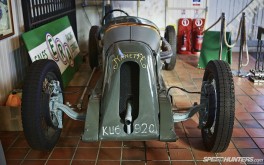
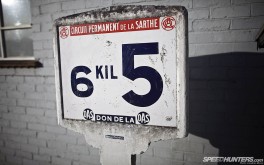
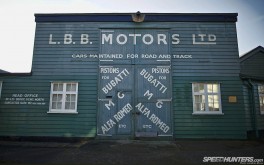
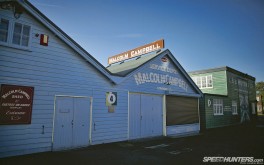





Wow was Bently the first to do the wheel mounted controls? I like looking at stuff like this because it give you a idea how our hobby/lifestyle has changed over the decades and how old some of thesd ideas are. Brake duct cooling, wheel mounted controls, and aero are as old as dirt itself. Also it shows how long it took some of the racing ideas to get perfected. Brakes is something i see they finally got right. LOL. Those early examples where the equivalent or putting bicycle brakes on a Gallardo. Scary indeed. I see why they were smoking cigarettes and drinking because your car will kill you before the lung cancer. LoL.
Great Article
Another fantastic history post. Kickass guys!
Little do people know, that Alfa Romeo was built in Croatia...
Can we be looking forward to a feature on the Napier Railton soon then? I hope so, what a car!
Glad you liked our little corner of.... the banking thats left
The Alfa was used in an escape from the eastern bloc by two brothers, ex freedom fighters during WW2 if memory serves me correct, its got such a brilliant back story about how it ended up at brooklands.
- and the F1 cars actually a dummy for the simulator I believe (Im good friends with a brooklands in house mechanic and the curator of models).
oh and one last thing.....
The staff at brooklands are lovely, most of them are petrolheads who genuinely love standing round and talking about the history of the cars, site and planes so give it a visit - it needs all the support it can get!
and driven right out of it at quite a speed!
@Skiptaylor It's a great story isn't it - worth a feature on its own perhaps!
@tonywinkens You can indeed – tomorrow!
You guys should consider visiting the Lohéac Museum in France. From what I remember, it had about 20 F1 from various era and a large array of rare cars.
@Chris Besset Thanks for the tip – there are a couple of museums in France on my list already!
Loving this coverage! Keep it up.
Great shot of the little kid!!!
Hi and Thanks again Mr.Moore. I truly love and apppreciate your MAXI POST's. Sooo much info, so many gems of great cars I would otherwise never know existed. (the 1928 golden arrow 925hp NA WTF?!!)
I wanted to say this last year after reading http://www.speedhunters.com/2012/11/classic-car-show-1/, I was just too lazy.
I too am a huge fan of Marcos and rare british race cars, exotics etc. mostly cause I'm across the pond and envious. Tvr speed 12, sagaris, connaught d10, brm v16 etc. This would be a college text book i wouldnt mind paying for!!
My inner Speed Racer is forever grateful.
@Jonathan Moore oh hell yes! - did you know you where about 2 miles from the mclaren car storage unit over in Woking? - now that's a place I would love to get into! - oh and mclaren do a staff car show every year in the summer, it's brilliant living round here and being a speedhunter!
Thank you Jonathan for showing us the history of racing again!
Blast from the past! It's so scary to think of how racing got started with virtually no safety equipment, just a big ol' pair of brass cojones and a need for speed!
I agree with the above, a superb history post!